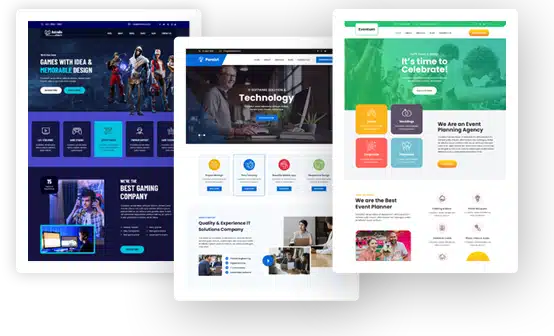Common Website Design Mistakes and How to Avoid Them

Think of your website today like your main hub online. It’s the first thing customers see. It is like your digital shop where you connect with customers. However, building a website that actually works is not always easy.
Many businesses make mistakes that can hurt how their site performs. As a result, it can ultimately slow down their success. In this article, let’s take a look at the common website design slip-ups and see practical tips to steer clear of them.
1. Neglecting User Experience
The main critical error in website design is prioritizing aesthetics over usability. A visually stunning website may get attention. However, if users can’t go through it easily or find what they need, they’ll leave. Poor user experience may be due to confusing navigation menus, unclear calls-to-action (CTAs), or cluttered layouts. Here’s what you can do:
- Conduct user research: Research your target audience’s needs, preferences, and behaviors. To get insights, you can use surveys, heatmaps, or A/B testing.
- Simplify navigation: Create intuitive menus with clear labels. Try to limit the number of menu items to avoid overwhelming users.
- Optimize CTAs: Make sure that the buttons are prominent, action-oriented, and strategically placed. For example, a “Buy Now” button should stand out on an e-commerce product page.
- Test usability: Regularly conduct usability testing to identify pain points and refine the user journey.
2. Ignoring Mobile Responsiveness
With over half of all internet traffic now happening on mobile devices, if your website isn’t working well on a smartphone, you will be missing a ton of traffic. To avoid this, try to:
- Adopt responsive design and test across devices: Use flexible grids, images, and CSS media queries to make sure your website works seamlessly to different screen sizes. Regularly test your site on various devices and browsers to ensure consistent performance.
- Prioritize mobile-first design and optimize load times: Start designing for smaller screens and scale up, ensuring core features are accessible on mobile. Try to compress images and minimize heavy scripts.
3. Overloading with Visual Clutter
To make a website “engaging,” some designers cram in too many elements into a single page such as animations, pop-ups, bright color, and excessive fonts. Too many of these elements can overwhelm visitors and dilute the website’s message. To solve this:
- Embrace minimalism and limit color palettes: Use white space to create a clean, focused layout that guides users’ attention to key elements. Also make sure to stick to a cohesive color scheme with two to three primary colors and complementary accents.
- Choose fonts wisely: Use no more than two fonts like one for headings and one for body text to maintain consistency.
- Use fewer animations: Subtle animations can improve UX, but avoid excessive motion that distracts from content.
4. Slow Page Load Times
Speed is a make-or-break factor in website performance. Studies show that users expect pages to load in under three seconds. A one-second delay can significantly increase bounce rates. Slow load times often stem from unoptimized images, heavy code, or poor hosting choices. To solve this issue, try to:
- Optimize images: Compress images without sacrificing quality using tools like TinyPNG.
- Minimize code: You can minimize your code usage by removing unnecessary plugins, minifying CSS and JavaScript, and using browser caching.
- Choose reliable hosting and use a content delivery network: Invest in a high-quality hosting provider with fast servers and good uptime. Also use CDNs to distribute content across global servers which helps reduce latency for users worldwide.
Always monitor your site’s performance using tools like Google PageSpeed Insights to find and fix speed issues.
5. Weak or Inconsistent Branding
Your website is an extension of your brand. Yet many businesses fail to maintain consistent branding across their site. This includes inconsistent logos, inconsistent colors, or mixed messaging. To solve this, try to:
- Create a style guide and align visuals with brand identity: Document your brand’s colors, fonts, logo usage, and tone of voice. Use imagery and design elements that reflect your brand’s personality; professional, playful, or innovative.
- Maintain consistency across pages and incorporate brand storytelling: Make sure that every page, from the homepage to the contact form, feels cohesive. Use your “About” page or visuals to convey your brand’s mission and values.
6. Neglecting Search Engine Optimization (SEO)
A website will be useless if no one can find it. Many designers overlook SEO. They focus solely on visuals and functionality, so this results in poor search engine rankings and lowers your organic traffic. For expert guidance on creating an SEO-friendly site, consider exploring professional website design services. For SEO issues, you can try:
- Optimize on-page elements and Improve site structure: Use relevant keywords in titles, headings, meta descriptions, and alt text for images. And create a logical hierarchy with clear URLs and internal linking to help search engines crawl your site.
- Focus on content quality: Publish high-value, original content that addresses your audience’s needs and incorporates keywords naturally.
- Monitor SEO performance: Use tools like Google Analytics or SEMrush to track rankings and refine your strategy.
7. Inadequate Accessibility
To help people with disabilities, you should consider accessibility. When you ignore accessibility, you’re not only excluding a portion of your audience but it can also lead to legal repercussions in some regions. As a result, try to:
Follow WCAG guidelines and Use alt text
Adhere to the Web Content Accessibility Guidelines (WCAG) for standards on contrast, text size, and keyboard navigation. Don’t forget to add descriptive alt text to images for screen readers.
- Ensure keyboard navigation: Make sure all interactive elements are accessible via keyboard for users who can’t use a mouse.
- Test with accessibility tools: Use tools like WAVE or axe to identify and fix accessibility issues.
8. Failing to Include Clear Calls-to-Action
Vague or missing CTAs can leave users unsure of what to do next. Try to:
- Make CTAs prominent and use action-oriented language: Use contrasting colors and bold text to make buttons stand out. Phrases like “Get Started,” “Shop Now,” or “Contact Us” prompt immediate action.
- Place CTAs strategically: Place CTAs where users are most likely to engage like at the end of a blog post or on a product page. Try to experiment with different designs, placements, and wording to optimize conversions.
9. Not Updating Content Regularly
If your website’s just sitting there with old blog posts, products nobody sells anymore, or info that’s completely out of date, visitors will notice, and so will Google. So try to,
- Schedule content audits: Review your site quarterly to remove or update outdated material.
- Publish fresh content and update visuals: Maintain a blog or news section to share industry insights, company updates, or tips.Refresh images and graphics to keep the site modern and relevant.
- Monitor analytics: Use data to identify underperforming pages and improve them.

